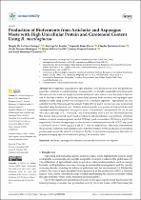| dc.contributor.author | De La Cruz-Noriega, Magaly | |
| dc.contributor.author | M. Benites, Santiago | |
| dc.contributor.author | Rojas-Flores, Segundo | |
| dc.contributor.author | Quiñones-Cerna, Claudio | |
| dc.contributor.author | Terrones Rodríguez, Nicole | |
| dc.contributor.author | Robles-Castillo, Heber | |
| dc.contributor.author | Huanes-Carranza, Johnny | |
| dc.contributor.author | Mendoza-Villanueva, Karol | |
| dc.date.accessioned | 2024-03-27T17:22:49Z | |
| dc.date.available | 2024-03-27T17:22:49Z | |
| dc.date.issued | 2023 | |
| dc.identifier.uri | https://hdl.handle.net/20.500.13067/3060 | |
| dc.description.abstract | Microorganisms’ degradation of agro-industrial waste produces bad odors and greenhouse
gases that contribute to global warming. Consequently, eco-friendly, sustainable biotechnological
alternatives to this waste are sought to provide additional value, which is why this study’s objective
was to develop a method of producing unicellular proteins from artichoke and asparagus agroindustrial waste using Rhodotorula mucilaginosa as a producer organism. Agricultural soil was
collected from the Universidad Nacional de Trujillo (Peru), and R. mucilaginosa was isolated and
identified using biochemical tests. Proteins and carotenoids were produced from artichokes and
asparagus residues using the R. mucilaginosa yeast. Four substrate concentrations (10, 20, 30, and
40%) and a pH range (5–8.1) were used. They were incubated at 30 ◦C for 72 h. The results showed
that protein and carotenoid yield varied according to pH and substrate concentration. Artichoke
residues reached a maximum protein yield of 25.98 mg/g and carotenoids of 159.26 µg/g at pH 5–6.6,
respectively. Likewise, the asparagus residue showed a maximum protein yield of 20.22 mg/g and
a carotenoid yield of 358.05 µg/g at a pH of 7.1 and 6.6, respectively. This study demonstrated
the potential of artichoke and asparagus agro-industrial residues for the production of unicellular
proteins and carotenoids using R. mucilaginosa. Further, it represents an appropriate alternative to
properly managing agro-industrial waste, giving it an economic value. | es_PE |
| dc.format | application/pdf | es_PE |
| dc.language.iso | eng | es_PE |
| dc.publisher | MDPI | es_PE |
| dc.rights | info:eu-repo/semantics/openAccess | es_PE |
| dc.rights.uri | https://creativecommons.org/licenses/by/4.0/ | es_PE |
| dc.subject | Artichoke | es_PE |
| dc.subject | Asparagus | es_PE |
| dc.subject | Bioferments | es_PE |
| dc.subject | Carotenoids | es_PE |
| dc.subject | Rhodotorula mucilaginosa | es_PE |
| dc.title | Production of Bioferments from Artichoke and Asparagus Waste with High Unicellular Protein and Carotenoid Content Using R. mucilaginosa | es_PE |
| dc.type | info:eu-repo/semantics/article | es_PE |
| dc.identifier.journal | Sustainability | es_PE |
| dc.subject.ocde | https://purl.org/pe-repo/ocde/ford#2.07.00 | es_PE |
| dc.source.volume | 15 | es_PE |
| dc.source.issue | 20 | es_PE |
| dc.source.beginpage | 1 | es_PE |
| dc.source.endpage | 9 | es_PE |


